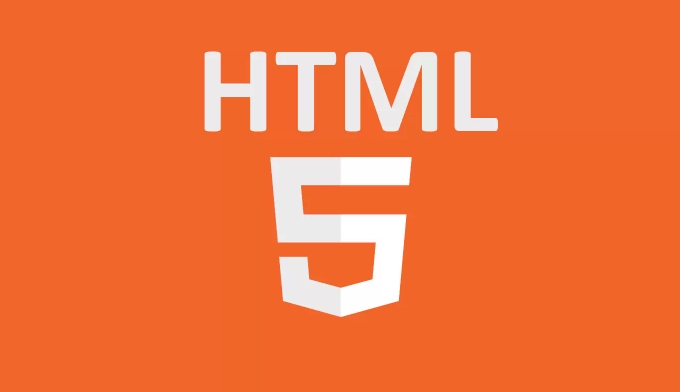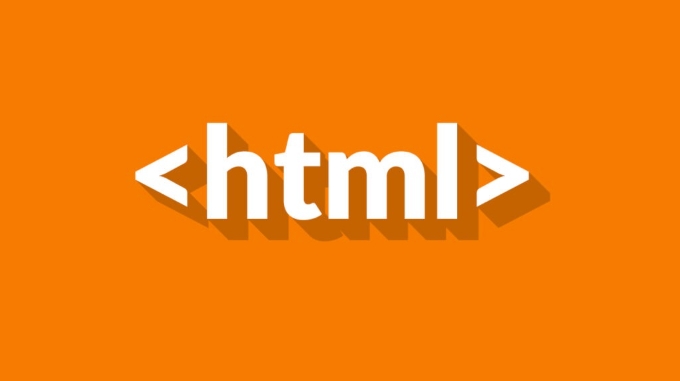HTML5 is the modern standard of HTML, introducing key improvements over older versions. 1. New semantic elements like

HTML and HTML5 aren't two completely different languages — HTML5 is simply the latest version of HTML (HyperText Markup Language). But the differences between "classic" HTML (often referring to HTML 4.01 or XHTML) and HTML5 go beyond just a version number. Here’s a clear breakdown of what changed and why it matters.

1. New Semantic Elements
One of the biggest improvements in HTML5 is the introduction of semantic tags that make web structure more meaningful.
-
Old HTML: Relied heavily on
<div> tags with classes like <code><div class="header"> or <code><div class="nav">.<li> <strong>HTML5</strong>: Adds built-in meaning with tags like:<ul> <li> <code><header></header>– for page or section headers -
<footer></footer>– for footers -
<nav></nav>– for navigation menus -
<article></article>– for self-contained content (e.g., blog posts) -
<section></section>– for grouping related content -
<aside></aside>– for sidebar content
These help both developers and screen readers understand the layout better, improving accessibility and SEO.

2. Native Multimedia Support
Before HTML5, embedding video or audio required third-party plugins like Flash or QuickTime.
-
Old HTML: Used
<object></object>or<embed></embed>with plugins. -
HTML5: Introduces native elements:
<video src="movie.mp4" controls></video> <audio src="music.mp3" autoplay></audio>
No plugins needed — works directly in the browser.

3. Graphics and Visuals
HTML5 added built-in support for drawing and animations without relying on external tools.
- Canvas (
<canvas>): Allows dynamic, scriptable rendering of 2D shapes and bitmap images (great for games or data visualizations). - SVG support: Better integration of scalable vector graphics directly in markup.
Older HTML had no such capabilities without external plugins.
4. Improved Form Controls and Input Types
HTML5 expands form functionality with new input types and attributes.
New input types include:
<input type="email">– validates email format<input type="date">– brings up a date picker<input type="number">,range,tel,url, etc.
Also adds helpful attributes like:
placeholder– hint text inside inputsrequired– enforces field completionautofocus– sets focus on page load
This reduces the need for JavaScript validation and improves UX.
5. APIs and Advanced Features
HTML5 isn’t just about markup — it comes with a suite of JavaScript APIs that enable richer web apps:
- Local Storage: Store data locally in the browser (
localStorage,sessionStorage) - Geolocation: Get user location via JavaScript
- Drag and Drop: Native support for moving elements
- Offline Web Apps: Work without internet using application cache (though now largely replaced by Service Workers)
- Web Workers: Run JavaScript in the background
These made web apps more powerful, rivaling desktop software.
6. Simplified Doctype and Charset
HTML5 made setup easier and more consistent.
- Old HTML: Complex doctype:
<!DOCTYPE html PUBLIC "-//W3C//DTD XHTML 1.0 Transitional//EN" "http://www.w3.org/TR/xhtml1/DTD/xhtml1-transitional.dtd">
- HTML5: Simple and easy to remember:
<!DOCTYPE html>
Also, declaring character encoding is shorter:
<meta charset="UTF-8">
7. Backward Compatibility
HTML5 was designed to be backward compatible. Browsers that don’t recognize new elements usually treat them as inline elements, and you can style them with CSS. Plus, fallbacks (like using So, while HTML5 is technically just an evolution of HTML, it brought modern, powerful features that transformed the web from static documents into dynamic applications. Today, when people say "HTML," they almost always mean HTML5 — it’s the standard we use now. Basically, if you're building websites today, you're using HTML5 — and benefiting from its cleaner code, better semantics, and richer functionality.<article></article> isn’t supported) make it safe to use.
In Summary: Key Differences at a Glance
Feature
HTML (pre-5)
HTML5
Semantic structure
<div class="nav"></div>
<nav></nav>, <header></header>, <article></article>
Audio/Video
Plugins (Flash, etc.)
Native
<audio></audio>, <video></video>
Graphics
Limited, plugin-dependent
<canvas>, SVG support
Form inputs
Basic text, password, etc.
Email, date, range, validation
API support
Minimal
Geolocation, storage, workers
Doctype
Long and complex
The above is the detailed content of HTML vs HTML5 what's the difference?. For more information, please follow other related articles on the PHP Chinese website!

Hot AI Tools

Undress AI Tool
Undress images for free

Undresser.AI Undress
AI-powered app for creating realistic nude photos

AI Clothes Remover
Online AI tool for removing clothes from photos.

Clothoff.io
AI clothes remover

Video Face Swap
Swap faces in any video effortlessly with our completely free AI face swap tool!

Hot Article

Hot Tools

Notepad++7.3.1
Easy-to-use and free code editor

SublimeText3 Chinese version
Chinese version, very easy to use

Zend Studio 13.0.1
Powerful PHP integrated development environment

Dreamweaver CS6
Visual web development tools

SublimeText3 Mac version
God-level code editing software (SublimeText3)
 Applying Semantic Structure with article, section, and aside in HTML
Jul 05, 2025 am 02:03 AM
Applying Semantic Structure with article, section, and aside in HTML
Jul 05, 2025 am 02:03 AM
The rational use of semantic tags in HTML can improve page structure clarity, accessibility and SEO effects. 1. Used for independent content blocks, such as blog posts or comments, it must be self-contained; 2. Used for classification related content, usually including titles, and is suitable for different modules of the page; 3. Used for auxiliary information related to the main content but not core, such as sidebar recommendations or author profiles. In actual development, labels should be combined and other, avoid excessive nesting, keep the structure simple, and verify the rationality of the structure through developer tools.
 How to group options within a select dropdown using html?
Jul 04, 2025 am 03:16 AM
How to group options within a select dropdown using html?
Jul 04, 2025 am 03:16 AM
Use tags in HTML to group options in the drop-down menu. The specific method is to wrap a group of elements and define the group name through the label attribute, such as: 1. Contains options such as apples, bananas, oranges, etc.; 2. Contains options such as carrots, broccoli, etc.; 3. Each is an independent group, and the options within the group are automatically indented. Notes include: ① No nesting is supported; ② The entire group can be disabled through the disabled attribute; ③ The style is restricted and needs to be beautified in combination with CSS or third-party libraries; plug-ins such as Select2 can be used to enhance functions.
 Implementing Clickable Buttons Using the HTML button Element
Jul 07, 2025 am 02:31 AM
Implementing Clickable Buttons Using the HTML button Element
Jul 07, 2025 am 02:31 AM
To use HTML button elements to achieve clickable buttons, you must first master its basic usage and common precautions. 1. Create buttons with tags and define behaviors through type attributes (such as button, submit, reset), which is submitted by default; 2. Add interactive functions through JavaScript, which can be written inline or bind event listeners through ID to improve maintenance; 3. Use CSS to customize styles, including background color, border, rounded corners and hover/active status effects to enhance user experience; 4. Pay attention to common problems: make sure that the disabled attribute is not enabled, JS events are correctly bound, layout occlusion, and use the help of developer tools to troubleshoot exceptions. Master this
 Configuring Document Metadata Within the HTML head Element
Jul 09, 2025 am 02:30 AM
Configuring Document Metadata Within the HTML head Element
Jul 09, 2025 am 02:30 AM
Metadata in HTMLhead is crucial for SEO, social sharing, and browser behavior. 1. Set the page title and description, use and keep it concise and unique; 2. Add OpenGraph and Twitter card information to optimize social sharing effects, pay attention to the image size and use debugging tools to test; 3. Define the character set and viewport settings to ensure multi-language support is adapted to the mobile terminal; 4. Optional tags such as author copyright, robots control and canonical prevent duplicate content should also be configured reasonably.
 Best HTML tutorial for beginners in 2025
Jul 08, 2025 am 12:25 AM
Best HTML tutorial for beginners in 2025
Jul 08, 2025 am 12:25 AM
TolearnHTMLin2025,chooseatutorialthatbalanceshands-onpracticewithmodernstandardsandintegratesCSSandJavaScriptbasics.1.Prioritizehands-onlearningwithstep-by-stepprojectslikebuildingapersonalprofileorbloglayout.2.EnsureitcoversmodernHTMLelementssuchas,
 How to associate captions with images or media using the html figure and figcaption elements?
Jul 07, 2025 am 02:30 AM
How to associate captions with images or media using the html figure and figcaption elements?
Jul 07, 2025 am 02:30 AM
Using HTML sums allows for intuitive and semantic clarity to add caption text to images or media. 1. Used to wrap independent media content, such as pictures, videos or code blocks; 2. It is placed as its explanatory text, and can be located above or below the media; 3. They not only improve the clarity of the page structure, but also enhance accessibility and SEO effect; 4. When using it, you should pay attention to avoid abuse, and apply to content that needs to be emphasized and accompanied by description, rather than ordinary decorative pictures; 5. The alt attribute that cannot be ignored, which is different from figcaption; 6. The figcaption is flexible and can be placed at the top or bottom of the figure as needed. Using these two tags correctly helps to build semantic and easy to understand web content.
 HTML for email templates tutorial
Jul 10, 2025 pm 02:01 PM
HTML for email templates tutorial
Jul 10, 2025 pm 02:01 PM
How to make HTML mail templates with good compatibility? First, you need to build a structure with tables to avoid using div flex or grid layout; secondly, all styles must be inlined and cannot rely on external CSS; then the picture should be added with alt description and use a public URL, and the buttons should be simulated with a table or td with background color; finally, you must test and adjust the details on multiple clients.
 How to embed content from another site using the html iframe tag?
Jul 04, 2025 am 03:17 AM
How to embed content from another site using the html iframe tag?
Jul 04, 2025 am 03:17 AM
Use tags to embed other website content into your own web page. The basic syntax is:, you can add width, height, and style="border:none;" to control the appearance; in order to achieve responsive layout, you can set the size through percentage or use containers to combine padding and absolute positioning to maintain the aspect ratio, while paying attention to cross-domain restrictions, loading performance, SEO impact, and security policies. Common uses include embedding maps, third-party forms, social media content and internal system integration.







